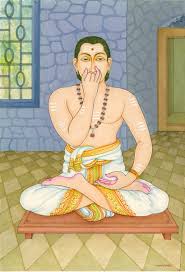Beginner’s Guide to Pranayama: The control of the life-force
 The asana, when practised successfully, affects a marked internalization of consciousness. Therefore it is said to make the yogi insensitive to the impact of the ‘pairs of opposites’ (dvandva) such as heat and cold, light and darkness, quiet or noise, etc. The next step consists in the ‘energizing through the practice of pranayama or the ‘control of the life force’. Prana should not be identified with mere breath. It is the all – penetrating energy which sustains all organic life, breathing being merely its external aspect. That rhythmic inhalation and exhalation as well as aspect. That rhythmic inhalation and exhalation as well as prolonged retention of the breath have a powerful effect on the mind must have been discovered early in the history of Yoga, presumably in connection with ritual chanting. In the Atharvaveda already the various ‘functions’ of Prana are distinguished. In subsequence times pranayama became one of the chief means of checking the ever-fickle mind. As the Yogasiksha – Upanisad declares.
The asana, when practised successfully, affects a marked internalization of consciousness. Therefore it is said to make the yogi insensitive to the impact of the ‘pairs of opposites’ (dvandva) such as heat and cold, light and darkness, quiet or noise, etc. The next step consists in the ‘energizing through the practice of pranayama or the ‘control of the life force’. Prana should not be identified with mere breath. It is the all – penetrating energy which sustains all organic life, breathing being merely its external aspect. That rhythmic inhalation and exhalation as well as aspect. That rhythmic inhalation and exhalation as well as prolonged retention of the breath have a powerful effect on the mind must have been discovered early in the history of Yoga, presumably in connection with ritual chanting. In the Atharvaveda already the various ‘functions’ of Prana are distinguished. In subsequence times pranayama became one of the chief means of checking the ever-fickle mind. As the Yogasiksha – Upanisad declares.
#100/200/300/500 hour Yoga teacher training India
Consciousness (citta) is connected with the life force indwelling in dwelling in all beings. Like a bird tied to a sting so is this mind. The mind is not brought under control by many considerations. The (only means for its control is nothing else but the life force.
#100/200/300/500 hour Yoga teacher training India
In addition to its ‘energizing’ function, pranayama is also meant to cure the normal irregularities of breathing which disturb the yogi concentration. Greatest focalization of consciousness is achieved in the state of suspended breathing (kumbhaka). This is the moment between inhalation (puraka) and exhalation (recaka). Patañjali speaks furthermore of a ‘fourth’ rhythm of breathing which probably refers to the involuntary respiratory activity during deep absorption and ecstasy.
#100/200/300/500 hour Yoga teacher training India
In Hatha yoga pranayama plays a dominant role, where it is employed both a means of internalizing consciousness and as a medical tool to cure illnesses according to the tantric maxim that and bhakti or spiritual life and worldly enjoyment are not opposed to each other.
